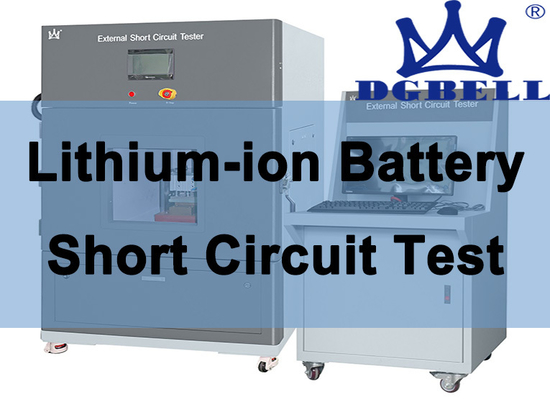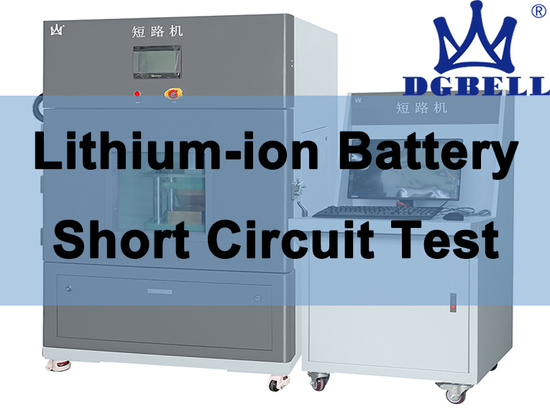
#Industry News
Internal Short Circuit Test of Lithium ion Battery
Internal Short Circuit Test of Lithium ion Battery
Lithium-ion batteries are widely used in various fields such as mobile devices, energy storage and new energy vehicles with their advantages of high cycle life than energy, but compared with other types of batteries, their safety is the main problem that needs to be solved. Lithium-ion batteries produce safety problems mainly through heat generation, and finally the way of thermal runaway embodiment and the reasons for the formation of thermal runaway are mainly short circuit, connection failure, high temperature baking, immersion in water, etc., of which short circuit is the most common cause of thermal runaway Short circuit is divided into external short circuit and internal short circuit, external short circuit can be controlled through the protection of auxiliary components and the optimization of the strategy while the internal short circuit is difficult to effectively control. In this paper, the systematic study of the simulation method of internal short circuit principle and preventive detection measures will have a deeper understanding of the control method of battery safety problems and provide reference for the wider application of lithium-ion batteries.
Short-circuit Simulation Test Method
Nail penetration, extrusion, drop, heavy impact and other tests are the more common simulated short circuit test methods in the standard, such as QC/T743-2006, SAND2005-3123, UL2580-2011, SAE2464 and other standards.
In order to better simulate the short-circuit effect, the various test methods are conditionally constrained in the standard. Acupuncture tests specify the needle pricking speed (QC/T743-2006 requires 10~40mm/s, other standards require 80mm/s) needle diameter (generally 3~8 mm); The extrusion experiment specifies the amount of deformation of the extrusion pressure (100 kN or 1000 times the mass of the specimen) (generally 50% of the deformation) and the shape of the extrusion disc (30 mm extrusion plate with a radius of 75 mm); The drop test specifies the conditions for the drop height (1 to 2 m) and the contact surface (hard horizontal ground or non-flat) at the time of the fall.
The simulated short-circuit experimental method also includes unlimited overcharge heating experiment parallel equivalent resistor. Unlimited overcharge is to charge the fully charged test battery with a constant current until the voltage drops to 0V or produce a combustion explosion is small: the heating experiment is to heat the experimental sample, the heating temperature is determined by the temperature resistance of the diaphragm, and the shrinkage of the diaphragm after heating causes an internal short circuit: The parallel equivalent resistance is mainly aimed at the parallel monomer, and one of the monomers is switched with an equivalent resistor to simulate an internal short circuit.
The advantage of the above method is that it is simple and conducive to implementation, while the disadvantage is that it only reflects the apparent phenomenon after the internal short circuit, and the accumulation of thermal energy that has been generated before the internal short circuit without restriction overcharging cannot be well defined for the heat released after the short circuit. In addition, there is also a certain uncertainty in which part of the cell the internal short circuit caused by the above method 14 has certain limitations on the mechanism analysis.
Forced internal short circuit is mainly to add metal embedded parts and diaphragm puncture holes inside the battery and then combine the form of external extrusion to achieve internal short circuits in different parts of the battery. In addition, the short circuit center is evaluated by adding a low melting point metal or alloy to the electrode by heating and melting it by monitoring voltage temperature, sound, light, and other ways (6. These methods can better reflect the impact of short circuits in different parts on the battery Is conducive to mechanism analysis The disadvantage is that the battery needs to be isolated from the air during the dismantling and assembly process, and there are also strict requirements for humidity, cleanliness, and package level.
Internal short-circuit prevention measures and detection methods
1.Internal short circuit prevention measures
(1) Battery materials, process improvement
It is mainly prevented by switching to the use of diaphragm materials and using electrolyte additives to prevent impurities from being mixed in the battery production process and the reliability test of the production process.
The risk of short circuits can be minimized by using ceramic diaphragms. If a short circuit is unavoidable, the short circuit current can also be reduced by coating the electrode material with a layer of PTC material, so as to increase the resistance of the PTC layer when the short circuit occurs, thereby suppressing the generation of thermal runaway. In addition, because the electrolyte currently used is based on the alkyl carbonate system is easy to volatilize and burn in the battery improper use of heat accumulation will produce combustion or explosion by designing the electrolyte as a flame retardant electrolyte or using ionic liquid electrolyte or adding maleimide oligomer material will greatly reduce the safety risks generated by short circuits.
Optimize and improve the battery cell production impurity removal process to remove iron metal dust, on the one hand, to prevent irreversible side reactions with the electrolyte during charging and discharging, on the other hand, the presence of impurity particles further increases the risk of puncturing the diaphragm and causing internal short circuits. X-ray can also be used to detect the alignment of the internal plates of the battery, thus avoiding the potential risk of short circuits.
(2) Battery use
Prevent low temperature charging of lithium evolution. Under low temperature conditions, the ion conductivity and diffusion coefficient of lithium-ion batteries are greatly reduced, which can easily lead to lithium evolution during charging, so the battery should be preheated to the appropriate charging temperature when using at low temperature, so as to avoid the battery from generating lithium dendrites and then puncturing the diaphragm when charging at low temperature.
Battery charge-discharge rate redundancy design. The redundant design allows the battery to always operate in a state of low load, which can effectively protect the battery and greatly reduce the risk of internal short circuits under high loads.
Enhance the thermal conductivity design of the battery or suppress the heat production ability because the internal short circuit of the battery will instantly generate a large amount of heat If the heat accumulates, it will lead to the decomposition of the electrolyte, the oxidation/reduction reaction between the electrolyte and the positive/negative surface of the positive and negative electrodes, and the shrinkage and decomposition of the diaphragm, resulting in thermal runaway.
2.A means of detecting short circuits inside the battery
Thermal detection: determine whether a short circuit has occurred by attaching a thermocouple to the battery side wall to detect temperature changes. Since the heat is conducted from the inside out when the short circuit occurs, the temperature shows that there is a certain lag, so that the short circuit situation cannot be fed back immediately.
Voltage anomaly detection monitors the internal short circuit situation of the battery by monitoring the voltage drop in the process of continuous small current charging, for example, when charging an 80Ah battery with a constant current of 3A, if the voltage drop exceeds 100mV, it is determined that the battery has an internal short circuit.
Capacity anomaly detection: There is a patent involving the detection method of internal short circuit: in the charging process, by comparing the charging capacity with the reference capacity within the currently set voltage range, because when the internal short circuit occurs, a part of the electrical energy will be converted into thermal energy dissipation, so that the charging capacity during the charging process will be higher than when the internal short circuit does not occur, so when the charging capacity is higher than the reference capacity, the internal short-circuit fault is reported When the charging capacity is lower than or equal to the reference capacity, the battery state is normal.
Summary
Lithium-ion battery internal short circuit is very easy to cause thermal runaway, so from the mechanism of the hand to grasp the cause of its formation, through simulation to further study it, so that through a variety of means to prevent and detect the lithium-ion battery internal short circuit, so as to ensure the safety of lithium-ion battery during use.







